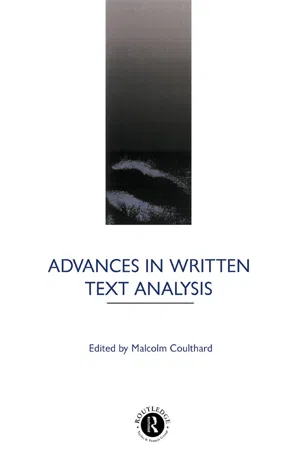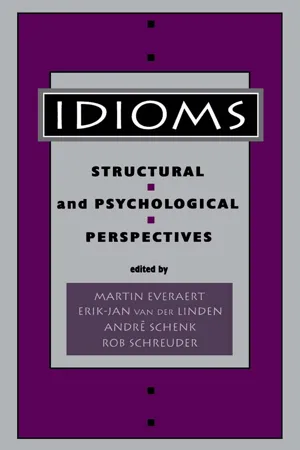Languages & Linguistics
Fixed Expressions
Fixed expressions are phrases or idioms that have a set structure and meaning that cannot be changed. They are often used in everyday language and are not typically altered or modified. Examples of fixed expressions include "kick the bucket" and "piece of cake." These expressions are important in understanding the nuances of a language and its cultural context.
Written by Perlego with AI-assistance
Related key terms
4 Key excerpts on "Fixed Expressions"
- eBook - ePub
- Malcolm Coulthard(Author)
- 2002(Publication Date)
- Routledge(Publisher)
8 The analysis of Fixed Expressions in text
Rosamund Moon
In general, studies of Fixed Expressions—idioms, formulae such as proverbs and catchphrases, and anomalous or ill-formed collocations—concentrate on their typological and syntagmatic properties. Attention is given to such things as the degree of their lexical and syntactic frozenness, or their transformation potential; and even the primary characteristic of idioms, their non-compositionality as lexical units, may be seen as a matter of the interpretation of a syntagm. However, it is their paradigmatic properties which are of importance in relation to interaction. Fixed Expressions represent meaningful choices on the part of the speaker/writer. They are single choices (see Sinclair 1987b: 321 and passim), and, as with other kinds of lexical item, their precise values and force should be considered in terms of the paradigm operating at each slot or choice. By taking into account paradigmatic as well as syntagmatic aspects, it is possible to assess the way in which Fixed Expressions contribute to the content, structure and development of a text.Fixed Expressions, especially highly colourful and metaphorical idioms and proverbs, are comparatively infrequent. They appear to be more frequent in spoken text than written, although to date there are few extensive studies of their actual distribution. Strässler assesses the frequency of idioms, excluding phrasal verbs, in spoken discourse as around one per 4.5 minutes of conversation (1982:81). A survey of 240 English proverbs (Arnaud and Moon, forthcoming) finds that there are around 33 instances of proverbs per million words of OHPC,1 and that the average frequency of each of the proverbs is much less than one occurrence per million words: this list of proverbs consists of those best known to informants in a small survey, and it should be pointed out that the more frequent of these proverbs nearly always occur in exploited or truncated forms, not the canonical citation forms. So in setting out to evaluate the textual contribution of Fixed Expressions, it is in fact difficult to find a text where their density is sufficiently high to make valid observations. A densely populated text would be atypical; while a densely populated section of a text would be unrepresentative by being decontextualized. With these caveats, I want to consider an editorial from The Guardian - eBook - ePub
Vocabulary
Applied Linguistic Perspectives
- Ronald Carter(Author)
- 2012(Publication Date)
- Routledge(Publisher)
4 but which (2) allows both for larger grammatical units to be built from their base, and for internal and external modification as more creative and cognitively richer speech is generated.Some examples of Fixed Expressions are: as a matter of fact, to smell a rat, as old as the hills, honesty is the best policy, further to my letter of the — th inst., spick and span, for good, if I were you, bottoms up, a watched pot never boils, a good time was had by all, light years ago, how do you do?, as far as I know, no way, you can say that again, in no uncertain terms, down with the Liberal Democrats, a stitch in time saves nine, I thought you’d never ask, by and large, like it or lump it. Such expressions as these are syntactically, semantically and discoursally varied, and classification necessarily involves some structural overlap. The tentative classification in Table 3.2 might, however, give an idea of the range of Fixed Expressions in the modern English lexicon as well as prepare some ground for the more formal recognition criteria suggested in the next section.The list contains Fixed Expressions which are generally known as clichés and proverbs. Proverbs have formal and semantic characteristics in common. For example they convey some kind of aphoristic truth, are usually in the simple present tense and are normally neither syntactically divisible nor substitutable (though this is not to say that creative mutations or distortions are not possible; see particularly Mackin, 1978 for a range of examples). On the other hand, the proverbs (1) honesty is the best policy, (2) a watched pot never boils and (3) a stitch in time saves nine display different degrees of semantic opacity. (1) can be derived from a knowledge of the individual constituent items, (2) is less transparent and requires a metaphoric-analogical interpretive process and (3) is semantically opaque, the meaning not being as openly recoverable. Clichés are like idioms in that they are Fixed Expressions but are unlike idioms in two important respects. They are more fixed than idioms in terms of syntactic, morphological and semantic commutability. Their meaning is usually derivable from the semantic sum of the individual constituent parts. When it is not derivable then features of the linguistic or social context will aid interpretation. For example, it is probable that ‘social’ clichés (social formulae/clichés at VII (i) in Table 3.2) like how do you do? (transparent) and bottoms up - eBook - ePub
Idioms
Description, Comprehension, Acquisition, and Pedagogy
- Dilin Liu(Author)
- 2017(Publication Date)
- Routledge(Publisher)
For example, Biber et al. (1999, p. 1024), in their comprehensive English grammar book, define idioms as “expressions with a meaning not entirely derivable from the meaning of their parts.” Similarly, the Cambridge dictionary of American idioms (2003), for example, defines idioms as follows: “An idiom is a phrase whose meaning is different from the meanings of each word considered separately. These phrases have a fixed form—they usually cannot be changed” (p. ix). ESL idiom publications often place a special emphasis on the invariance of structure as the most important feature of idioms. For instance, McMordie (1972), in the book English Idioms, states emphatically, “As a general rule an idiomatic phrase cannot be altered; no other synonymous word can be substituted for any word in the phrase, and the arrangement of the words can rarely be modified” (p. 6). This invariance feature presupposes that idioms are multiword expressions. Cowie and Mackin (1975) make the point very clear in their Oxford dictionary of current idiomatic English, for they begin their idiom definition by saying, “an idiom is a combination of two or more words which function as a unit of meaning” (p. ix). The reason for excluding single words as idioms for L2 learners is rather simple and obvious: no matter how difficult it is, a single word is just an individual vocabulary item, and to learn it is basically the same as to grasp any other regular individual word. Learning idioms, on the other hand, is a different matter as it involves the challenge of not only figuring out their unique meanings but also dealing with their invariance or restricted variance in form. In short, for L2 learners, idioms are perhaps best defined as multiword expressions that are invariant or variance-restricted in structure and often (not always) non- or semi-literal in meaning - eBook - ePub
Idioms
Structural and Psychological Perspectives
- Martin Everaert, Erik-Jan van der Linden, Andr' Schenk, Rob Schreuder, Robert Schreuder(Authors)
- 2014(Publication Date)
- Psychology Press(Publisher)
8Phrasemes in Language and Phraseology in Linguistics
Igor Mel’čuk Université de Montréal, CanadaINTRODUCTION: STATING THE PROBLEM
The Object, the Approach, the Framework
The presentation on which this chapter is based addressed the audience that gathered for a conference on idioms (whatever those are); because of this, I should probably have concentrated on idioms. However, I do not; instead, I discuss the larger set of NON-FREE PHRASES, of which idioms are only a small subset. Therefore, so that no one among my readers is ┌pissed off┐; at me, ┌flies off the handle┐, or ┌blows his/her top┐ and ┌comes at me hammer and tongs┐/┌tooth and nail┐—forcing me to ┌kick the (*famous) bucket┐, let me, ┌first of all┐, explain my ways. Please ┌take it easy┐; I will try to dispel your doubts by ┌seizing the bull by the horns┐. (As everyone has of course guessed, I use the symbols ┌and┐ to enclose idioms.)I start with a well-known definition of the concept (idiom) that I accept temporarily; here is its slightly adapted formulation.Definition 1: Idiom (a preliminary characterization; cf. Definition 5 )An idiom is a multilexemic expression E whose meaning cannot be deduced by the general rules of the language in question from the meanings of the constituent lexemes of E, their semantically loaded II morphological characteristics (if any) and their syntactic configuration.I think that Definition 1 specifies the right EXTENSION of the concept: It covers all and only the expressions that I call idioms myself. Yet I do not like its INTENSION and accordingly I later change it. But Definition 1 allows the reader to see clearly what I have in mind when I speak of idioms, so that I can proceed from it. Let me put forward the following five proposals that I adhere to:1. Idioms are considered, as I already said, within a larger set of expressions: as a subclass of nonfree, or set 〈=fixed, frozen〉 expressions of all possible kinds, which I call phrasemes . The set of phrasemes contains the set of idioms as its proper subset. My goal is to develop an outline of a deductive theory of phrasemes and then to show the exact place that the idioms occupy within this vast domain (in other terms, to formulate the differentia specifica of an idiom with respect to a phraseme, which is its genus proximum
Learn about this page
Index pages curate the most relevant extracts from our library of academic textbooks. They’ve been created using an in-house natural language model (NLM), each adding context and meaning to key research topics.



